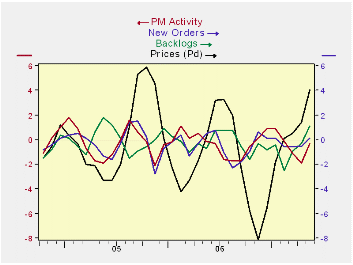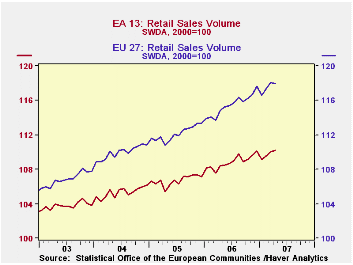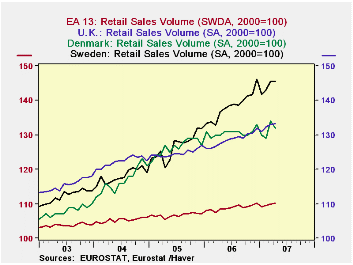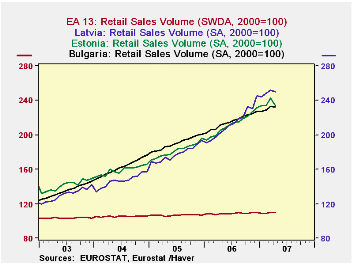 Global| Jun 05 2007
Global| Jun 05 2007Nonmfg ISM Strength is Cycling Higher - so are Prices
Summary
The nonmanufacturing ISM shows that its components are indeed cycling higher. Prices are up strongly. Backlogs while below the neutral value of 50 are nonetheless rising strongly from their six month average. Still, they edged lower [...]

The nonmanufacturing ISM shows that its components are indeed cycling higher. Prices are up strongly. Backlogs while below the neutral value of 50 are nonetheless rising strongly from their six month average. Still, they edged lower in the month of May. Orders also are edging higher. And activity is firming but not yet stronger on a three-month vs six- month comparison.
In May the nonmanufacturing ISM activity index moved up sharply. Orders also rose briskly. The report generated exactly the sort of strength we thought we would see after seeing employment strength in May.
The percentile positions of the various ISM components show a great deal of variation in the various ISM components (see table below). For the most part the readings are strong but not all are. The supplier deliveries reading, for example is in the bottom 12 percentile of its range and shows the same sort of slack or absence of tension on deliveries as the ISM MFG and other regional reports. Even as activity has ramped up slack has increased. Contrarily exports and inventories are at the top of their respective ranges going back to 1998. Activity is high in its range. Orders, prices and employment are at firm relative readings (Percentiles). While prices are 10 % above their average value, they have such large variation (std dev = 8.2) that they are still at a moderate position within their range of values.
Private nonmanufacturing jobs statistics are at the bottom of this table. Readings (monthly changes in nonmanufacturing jobs) are in the 65th percentile of their range since 1998 close to the 68.8 percentile for the nonmanufacturing ISM job diffusion reading. We appear to be getting consistent signals about the growing strength and firmness of the economy.
| ISM Non Manufacturing Statistics from Jan 1998 to Date | ||||||||||
|---|---|---|---|---|---|---|---|---|---|---|
| ISM-Non MFG | Current | Last Mo | Std Dev | Average | SD% Avg | MAX | MIN | Range | Percentile | % of AVG |
| PM Activity | 59.7 | 56.0 | 4.7 | 57.6 | 8.2 | 67.9 | 40.5 | 27.4 | 70.1 | 104 |
| New Orders | 57.4 | 55.5 | 4.7 | 57.2 | 8.2 | 66.9 | 41.3 | 25.6 | 62.9 | 100 |
| Backlogs | 48.0 | 50.0 | 3.7 | 51.0 | 7.2 | 57.0 | 40.5 | 16.5 | 45.5 | 94 |
| Supplier Deliveries | 49.5 | 51.0 | 2.2 | 53.6 | 4.1 | 60.5 | 48.0 | 12.5 | 12.0 | 92 |
| Inventory Sentiment* | 61.0 | 60.5 | 2.7 | 63.0 | 4.3 | 69.0 | 55.0 | 14.0 | 42.9 | 97 |
| Inventories | 61.0 | 52.0 | 3.3 | 50.6 | 6.6 | 61.0 | 43.5 | 17.5 | 100.0 | 121 |
| Prices | 66.4 | 63.5 | 8.2 | 60.1 | 13.6 | 80.5 | 41.3 | 39.2 | 64.0 | 110 |
| Employment | 54.9 | 51.9 | 3.7 | 51.7 | 7.1 | 59.9 | 43.9 | 16.0 | 68.8 | 106 |
| Export Orders | 66.0 | 55.5 | 4.6 | 55.0 | 8.4 | 66.0 | 44.5 | 21.5 | 100.0 | 120 |
| Import Orders | 55.5 | 52.5 | 4.0 | 54.8 | 7.3 | 63.5 | 45.5 | 18.0 | 55.6 | 101 |
| Private Non MFG jobs | 154.0 | 98.0 | 112.5 | 99.6 | 113.0 | 346.0 | -202.0 | 548.0 | 65.0 | 155 |
by Louise Curley June 5, 2007

Eurostat released preliminary data for April retail trade today for the aggregates of the 13 countries in the Euro Area and the 27 countries in the European Union. The preliminary data are based on reports by countries representing at least 60% of the weight of the total. As a result data for all countries are not available at this time.
Eurostat does not publish, nor is it possible to derive, an index for total retail trade of the "Fourteen" non Euro Area countries included in the total. However, the fact that retail trade in the Euro Area increased 0.18% in April from March while trade in the entire Union declined, albeit slightly, 0.05%, suggests that retail trade in the "Fourteen" declined in April. The first chart shows the indexes of retail trade in the Euro Area and the European Union. The widening gap between the two series suggests that the greater growth in the retail trade of the European Union has been due largely to the "Fourteen".
The "Fourteen" non Euro Area countries includes three developed countries--the United Kingdom, Sweden and Denmark and eleven emerging countries of central and eastern Europe. Retail trade in the three developed countries has shown more strength than the total of the Euro Area as can be seen in the second chart. This growth, however, falls short of the dramatic growth of retail trade in the central and eastern European countries, as shown in the third chart where the paths of retail trade in Latvia, Estonia and Bulgaria are taken as illustrative of the group of emerging countries. It should however be kept in mind that these countries began to grow only after the fall of the Berlin Wall hence their growth has been from a very low base compared with that of the developed countries.
Growth of retail trade within the Euro Area has varied widely with Germany being the laggard. The fourth chart compares retail trade in Germany with that of France, Finland, and Spain among those with good growth. It appears that retail trade in Germany may finally be showing signs of growth.

| VOLUME OF RETAIL TRADE EX AUTOS (SA, 2000=100) | Apr 07 | Mar 07 | Apr 06 | M/M % | Y/Y % | 2006 | 2005 | 2004 |
|---|---|---|---|---|---|---|---|---|
| European Area 13 | 110.22 | 110.02 | 108.41 | 0.18 | 1.67 | 108.84 | 106.72 | 105.32 |
| European Union 27 | 118.01 | 118.07 | 114.84 | -0.05 | 2.76 | 115.46 | 112.14 | 109.97 |
| France | 120.6 | 119.5 | 116.1 | 0.92 | 3.88 | 116.9 | 114.7 | 113.2 |
| Germany | 104.0 | 101.3 | 103.3 | 2.67 | 0.68 | 103.5 | 101.7 | 100.2 |
| Spain | 122.22 | 124.40 | 119.69 | -1.75 | 2.11 | 120.38 | 118.02 | 116.27 |
| Finland | 132.0 | 136.1 | 128.7 | -3.01 | 2.56 | 129.0 | 122.2 | 116.5 |
| United Kingdom | 133.14 | 133.09 | 127.45 | 0.04 | 4.46 | 128.65 | 124.65 | 122.28 |
| Sweden | 145.6 | 145.5 | 136.6 | 0.07 | 6.59 | 138.3 | 126.7 | 118.1 |
| Denmark | 132.0 | 134.0 | 130.0 | -1.49 | 1.54 | 130.7 | 126.4 | 116.8 |
| Latvia | 249.98 | 251.69 | 202.48 | -0.68 | 23.46 | 213.49 | 178.03 | 146.91 |
| Bulgaria | 232.14 | 232.71 | 210.84 | -0.24 | 10.10 | 215.48 | 190.29 | 102.49 |
| Estonia | 233.51 | 242.72 | 205.19 | -3.79 | 13.80 | 211.88 | 181.86 | 158.98 |
Robert Brusca
AuthorMore in Author Profile »Robert A. Brusca is Chief Economist of Fact and Opinion Economics, a consulting firm he founded in Manhattan. He has been an economist on Wall Street for over 25 years. He has visited central banking and large institutional clients in over 30 countries in his career as an economist. Mr. Brusca was a Divisional Research Chief at the Federal Reserve Bank of NY (Chief of the International Financial markets Division), a Fed Watcher at Irving Trust and Chief Economist at Nikko Securities International. He is widely quoted and appears in various media. Mr. Brusca holds an MA and Ph.D. in economics from Michigan State University and a BA in Economics from the University of Michigan. His research pursues his strong interests in non aligned policy economics as well as international economics. FAO Economics’ research targets investors to assist them in making better investment decisions in stocks, bonds and in a variety of international assets. The company does not manage money and has no conflicts in giving economic advice.






